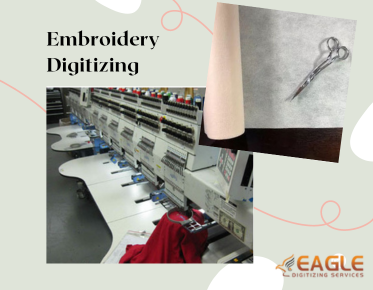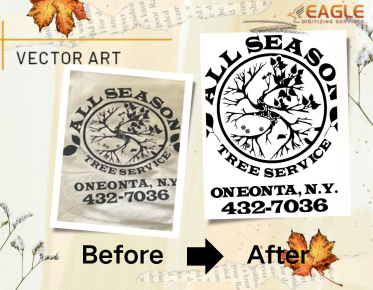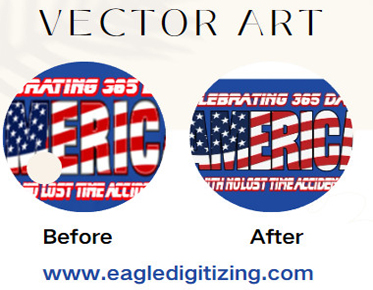Know Your Embroidery Machines: File Formats Made Simple
File formats play a crucial role in embroidery quality by dictating how designs are interpreted and executed by the machine. The accuracy of stitch placement, thread choice, and design details hinges on the format’s ability to convey this information correctly. Choosing the right format helps preserve the integrity of your design and achieves professional results. If this post spurred your interest and you want to find out more about Embroidery Digitizing, please feel free to contact us.
How Embroidery Machines Use Digital Files
Embroidery machines utilize digital files to execute designs. These files contain instructions for the machine, detailing how to stitch each element of the design. The machine reads the file, follows the stitch patterns, and applies the appropriate thread colors to reproduce the design accurately on the fabric.
Understanding Embroidery File Formats
What Makes an Embroidery File Format Unique?
An embroidery file format is unique because it encodes information specific to stitching, including stitch types, sequence, and color changes. Unlike standard image files, embroidery files are tailored to convey precise instructions that guide the embroidery machine in creating the design.
Key Characteristics of Embroidery Files
Key characteristics of embroidery files include stitch data, thread colors, and design dimensions. These files also specify the type of stitch to be used, the sequence in which stitches are applied, and any necessary color changes. Understanding these characteristics helps ensure that the design is accurately reproduced on fabric.
Common Terms and Concepts in Embroidery Digitizing
Common terms in embroidery digitizing include "stitch density," which refers to the number of stitches per inch, and "pathing," which describes the order in which stitches are applied. Other concepts include "digitizing," the process of converting artwork into stitch files, and "underlay," which provides a foundation for the design to improve stability and appearance.
Popular Embroidery Machine Brands and Their File Formats
Brother Embroidery Machines: Supported File Formats
Brother embroidery machines commonly support PES files, which are specifically designed for their models. PES files are versatile and widely used, making them a popular choice for Brother users. They include detailed stitching instructions and color information tailored for Brother machines.
Janome Embroidery Machines: Compatible Formats
Janome machines typically use JEF files. JEF format files are compatible with most Janome models and include the necessary stitch data and color information. Some newer models may also support JEF+ files, which offer additional features and capabilities.
Bernina Embroidery Machines: File Format Requirements
Bernina machines primarily use ART files. ART format files are designed for Bernina’s proprietary software and machines, providing detailed stitch instructions and color management. This format is optimized for Bernina’s advanced features and design capabilities.
Husqvarna Viking Embroidery Machines: File Types
Husqvarna Viking machines utilize VP3 files. VP3 files are designed to work with Husqvarna Viking’s embroidery software and machines, offering precise stitch and color data. This format ensures compatibility and high-quality results with Husqvarna Viking equipment.
Pfaff Embroidery Machines: Acceptable Formats
Pfaff embroidery machines use CND files. CND format files are tailored for Pfaff machines and include detailed stitch and color information. This format supports Pfaff’s advanced embroidery features and ensures the accurate reproduction of designs.
Singer Embroidery Machines: File Format Options
Singer machines generally support PES files, similar to Brother machines. PES files for Singer machines include stitch data and color information specific to Singer’s embroidery technology. Some models may also support DST files, providing additional flexibility.
File Formats for Home Embroidery Machines
PES Files: A Closer Look at Brother and Baby Lock Compatibility
PES files are widely used for Brother and Baby Lock embroidery machines. These files provide detailed instructions for stitching and color changes, ensuring accurate design reproduction. PES format is known for its broad compatibility and ease of use with various home embroidery machines.
JEF Files: What Janome Users Need to Know
JEF files are the standard format for Janome embroidery machines. This format contains stitch data and color information specific to Janome’s machine models. JEF files are essential for ensuring that designs are executed correctly and consistently on Janome machines.
DST Files: Understanding the Format for Multiple Brands
DST files are a popular format used by multiple embroidery machine brands, including Brother, Bernina, and others. This format is widely accepted due to its simplicity and compatibility with various machines. DST files encode stitch information and can be used across different brands, making them a versatile choice.
EXP Files: File Format for Various Embroidery Machines
EXP files are compatible with several embroidery machines, including models from Melco and Barudan. This format provides detailed stitch data and is suitable for a range of machines. EXP files are used for both home and commercial embroidery applications.
File Formats for Commercial Embroidery Machines
ART Files: Compatible with Bernina and Other Brands
ART files are designed for Bernina embroidery machines but are also compatible with other commercial machines. This format supports advanced features such as thread color management and stitch sequencing, making it ideal for complex commercial embroidery projects.
VP3 Files: What You Need to Know for Husqvarna Viking
VP3 files are specifically designed for Husqvarna Viking embroidery machines. This format includes detailed instructions for stitch placement and color changes, ensuring high-quality results with Husqvarna Viking’s advanced embroidery technology.
CND Files: Pfaff's Preferred File Format
CND files are the preferred format for Pfaff embroidery machines. This format provides precise stitch and color data, optimized for Pfaff’s machines. CND files ensure compatibility and accurate design reproduction for commercial embroidery applications.
HUS Files: Husqvarna Viking's Standard Format
HUS files are another format used by Husqvarna Viking machines. This format includes detailed stitch instructions and color information, supporting a range of embroidery tasks. HUS files are suitable for both home and commercial use with Husqvarna Viking equipment.
Converting Between File Formats
Why Conversion Is Necessary
Conversion between file formats is necessary to ensure compatibility with different embroidery machines and software. Different brands and models may use proprietary formats, requiring conversion to make designs usable across various devices. Proper conversion helps maintain design integrity and quality.
Best Practices for Converting Embroidery Files
When converting embroidery files, use reliable software to avoid data loss or corruption. Maintain the original file format until you have confirmed successful conversion. Test converted files on your machine to ensure they perform correctly and make any necessary adjustments.
Recommended Software for File Conversion
Recommended software for converting embroidery files includes Embird, Wilcom TrueSizer, and Hatch Embroidery Software. These programs offer robust tools for converting between various formats and ensure accurate translation of stitch and color data.
Software and Tools for Embroidery File Management
Overview of Popular Embroidery Software
Popular embroidery software includes Embird, Wilcom, and Hatch. These programs offer a range of features for digitizing, editing, and managing embroidery files. They provide tools for converting file formats, managing color palettes, and optimizing designs for different machines.
How to Use Software to Manage and Convert Files
Embroidery software allows you to manage and convert files by importing designs and selecting the desired output format. Use the software’s conversion tools to translate between formats and adjust design elements as needed. Save and organize files for easy access and efficient workflow.
Tools for Editing and Customizing Embroidery Designs
Editing and customizing tools in embroidery software include stitch editors, color managers, and design modifiers. Use these tools to adjust stitch density, modify design elements, and fine-tune colors. Customization options allow you to tailor designs to specific needs and preferences.
Troubleshooting Common File Format Issues
Common Problems with Embroidery File Formats
Common issues with embroidery file formats include incompatibility with machines, incorrect stitch placement, and color mismatches. These problems can arise from using unsupported formats or errors during file conversion. Identifying and addressing these issues is crucial for achieving accurate embroidery results.
How to Fix Errors and Incompatibilities
Fix errors and incompatibilities by checking file formats against machine specifications and converting files using reliable software. Review design files for any errors or discrepancies and make necessary adjustments. Testing the design on sample fabric can help identify and correct issues before full production.
Tips for Preventing File Format Issues
Prevent file format issues by using the correct file formats for your machine and maintaining updated software. Regularly back up your files and verify compatibility before starting a new project. Ensuring proper file management practices helps avoid common problems and ensures smooth operation.
Choosing the Right File Format for Your Project
How to Select the Best Format for Different Projects
Select the best file format based on your machine’s requirements and the complexity of your project. Consider factors such as stitch type, color changes, and design size. Choosing the appropriate format ensures compatibility and optimal quality for your embroidery projects.
Factors to Consider When Choosing a File Format
When choosing a file format, consider machine compatibility, design complexity, and project requirements. Ensure that the format supports the features needed for your design and that it is compatible with your embroidery machine. Assessing these factors helps achieve the best results.
Tips for Ensuring Compatibility and Quality
To ensure compatibility and quality, test designs in the chosen file format before starting full production. Use software to check and adjust file settings as needed. Confirm that the format supports all necessary design elements and functions correctly with your machine.
Tips for Preparing Files for Different Embroidery Machines
How to Prepare Files for Home vs. Commercial Machines
Prepare files for home machines by ensuring they are compatible with formats such as PES or JEF. For commercial machines, use formats like ART or VP3 that support advanced features. Adjust file settings based on machine specifications and test designs to ensure proper functionality.
Ensuring Your Design Works Across Various Machines
Ensure your design works across various machines by using universally compatible formats and conducting thorough tests. Verify that the design performs well on different machines and make any necessary adjustments. Consistent testing helps maintain design quality across multiple devices.
Tips for Testing and Proofing Your Embroidery Files
Test and proof your embroidery files by running sample stitches on fabric to check for accuracy and quality. Review stitch placement, color changes, and design details. Make adjustments based on test results to achieve the desired outcome and ensure successful production.
Understanding File Format Limitations
What to Watch Out for with Each File Format
Each file format has limitations, such as restricted stitch types or color palettes. Be aware of these limitations when selecting a format for your project. Understanding format constraints helps avoid design issues and ensures that your embroidery machine can handle the design effectively.
How File Formats Can Affect Design Quality
File formats can affect design quality by influencing stitch accuracy, color fidelity, and overall appearance. Formats that support detailed stitch instructions and color management contribute to higher-quality results. Choosing the right format helps preserve design integrity and achieve professional outcomes.
Addressing Limitations and Working Around Them
Address limitations by selecting file formats that best meet your project needs and adjusting design elements to fit format constraints. Use software tools to optimize designs and convert files as necessary. Working around limitations involves understanding the capabilities of your chosen format and making informed adjustments. Should this post have fanned the flames of your interest in Embroidery Digitizing in USA and you desire to delve deeper, don't hesitate to communicate with us.
Achieving optimal embroidery results requires a thorough understanding of file formats and their implications for design quality. By mastering file formats and applying best practices, you can produce stunning, professional-quality embroidery that meets your expectations and exceeds your clients’ needs.



